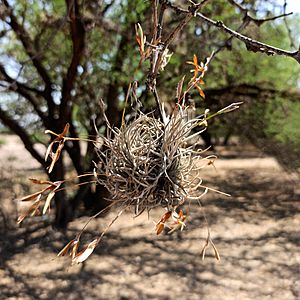Small ballmoss facts for kids
Quick facts for kids Small ballmoss |
|
|---|---|
 |
|
| Scientific classification | |
| Genus: |
Tillandsia
|
| Species: |
recurvata
|
| Synonyms | |
|
|
Tillandsia recurvata, often called small ballmoss or ball moss, is a special kind of flowering plant. It's not a true moss, even though its name might make you think so! It belongs to the Bromeliaceae family, which also includes pineapples.
This plant grows on other larger plants, like trees. It's called an epiphyte, which means it uses the host plant for support. It's not a parasite like mistletoe, because it doesn't steal food from its host. Instead, it makes its own food, just like its relative Spanish moss.
Contents
How Ball Moss Lives and Grows
Ball moss gets its food by photosynthesizing, using sunlight to make energy. It absorbs water that collects on its leaves. It also gets important nutrients like nitrogen from tiny bacteria and other minerals from dust in the air.
Even though ball moss grows on trees, it usually doesn't hurt them. It might compete a little for sunlight or space for new branches. But for healthy trees, ball moss rarely causes any problems.
What Ball Moss Looks Like
Tillandsia recurvata often grows into a round shape, like a golf ball or even a soccer ball. These "balls" are actually many smaller ball moss plants growing very close together.
How Ball Moss Spreads
Scientists believe that wind is the main way ball moss seeds travel. The seeds are very light and have fine hairs. These hairs help them stick to wet or rough surfaces, like tree bark. This gives the tiny seedlings enough time to grow roots and attach themselves. You can even see them growing on fences and telephone wires!
Ball moss doesn't like cold weather. It's especially sensitive to freezing temperatures when it's wet.
Where Ball Moss is Found
Ball moss naturally grows in the warmer parts of the Americas. You can find it from the southern United States all the way down to northern Argentina and Chile.
In the United States, it grows in states like Georgia, Florida, Louisiana, Texas, and Arizona. It's also common in Mexico, most of Central and South America, and many islands in the West Indies. Some people in the United States don't like how ball moss looks on their trees. They sometimes try to remove it using different sprays.
Uses of Ball Moss
Ball moss can be used as food for animals, also known as fodder.
The Pima of Mexico sometimes eat the flowers of T. recurvata and T. erubescens. They enjoy them because they have a lot of sugar.
Images for kids
See also
 In Spanish: Gallinita para niños
In Spanish: Gallinita para niños



